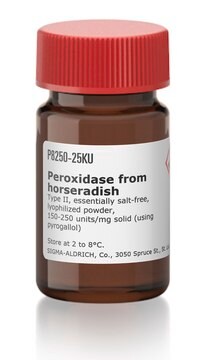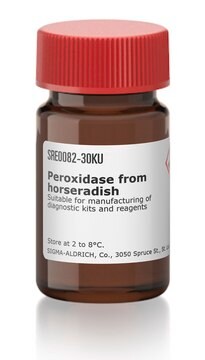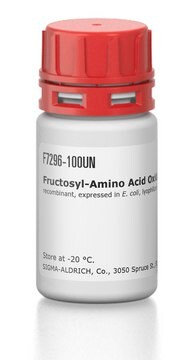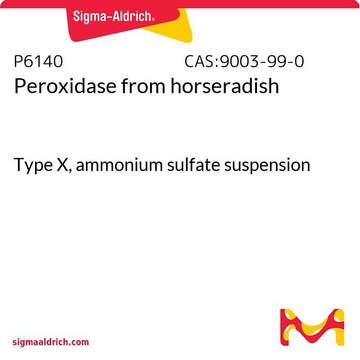11428861001
Roche
Peroxidase (POD), activated
from horseradish
Synonyme(s) :
POD
Se connecterpour consulter vos tarifs contractuels et ceux de votre entreprise/organisme
About This Item
Produits recommandés
Source biologique
horseradish
Niveau de qualité
Forme
lyophilized
Activité spécifique
800 units/mg protein (at 25 °C with ABTS and H2O2 as substrate (pH 5.0).)
Conditionnement
pkg of 8 mg (~40 mg lyophilizate)
Fabricant/nom de marque
Roche
pH optimal
6.0-6.5
Conditions d'expédition
wet ice
Température de stockage
2-8°C
Description générale
Donor: hydrogen-peroxide oxidoreductase
Reagent for the labeling of water-soluble substances carrying primary amino groups with peroxidase from horseradish (HRP).
Capacity: sufficient for approximately 6 mg IgG.
Reagent for the labeling of water-soluble substances carrying primary amino groups with peroxidase from horseradish (HRP).
Capacity: sufficient for approximately 6 mg IgG.
Peroxidase (POD) is an enzyme that includes a group of specific enzymes such as NAD peroxidase, NADP peroxidase, fattyacid peroxidase and a group of non specific enzymes from various sources. It is present in animals, higher plants and other organisms.
Application
Peroxidase (POD), activated has been used in terminal deoxyribonucleotidyl transferase (TDT)-mediated dUTP-digoxigenin nick end labeling (TUNEL) staining and immunohistochemistry.
The enzyme can be used without pre-activation for labeling water-soluble substances with reactive and accessible primary amino groups (e.g., peptides or proteins) with peroxidase for use in analytical methods. It is particularly suitable for the coupling of antibodies (Ig, Ig Fab, and Ig F(ab′)2 fragments from rabbit, mouse, sheep, and goat) with peroxidase. The resulting conjugate is optimal for use in immunochemical detection systems, for example, ELISA, immunohistochemistry, and immunoblotting procedures.
Actions biochimiques/physiologiques
Peroxidase (POD) helps in the dehydrogenation of several organic compounds like phenols, aromatic amines, hydroquinones etc.
Qualité
Isoenzymes: >90% isoenzyme C (HPLC)
Purity number: 3.0 - 3.5 (A403/A275)
Purity number: 3.0 - 3.5 (A403/A275)
Notes préparatoires
Stabilizers: Product is stabilized with sucrose.
Working concentration: 1:4,000 to 1:10,000
For ELISA
Working solution: Preparation of the solutions, (15 to 25 °C)
1. 1 M Sodium carbonate/-hydrogencarbonate solution, pH 9.4
1 M Na2CO3: Dissolve 10.6 g Na2CO3 in 80 ml double-dist. water and make up to 100 ml.
1 M NaHCO3: Dissolve 8.4 g NaHCO3 in 80 ml double-dist. water and make up to 100 ml.
Adjust the pH of the NaHCO3 solution to 9.4 by adding Na2CO3 solution.
2. 100 mM Sodium carbonate/-hydrogencarbonate solution, pH 9.8
Dilute 10 ml solution 1 to 100 ml with double-dist. water.
3. 200 mM Sodium borohydride solution
NB: Prepare the solution immediately prior to use and keep cold on ice. Dissolve 8 mg NaBH4 in 1 ml cold double-dist. water.
4. 2 M Triethanolamine solution, pH 8.0
Dilute 2.66 ml triethanolamine with 3 ml double-dist. water, adjust the pH to 8.0 with 25% HCI and make up to 10 ml with double-dist. water.
5. 1 M Glycine solution, pH 7.0
Dissolve 0.75 g glycine in ca. 6 ml double-dist. water, adjust to pH 7.0 with 0.1 M NaOH, and make up to 10 ml with double-dist. water.
6. PBS (phosphate-buffered saline); glycine; pH 7.4.
10 mM Potassium phosphate, 200 mM NaCI, 10 mM glycine, pH 7.5.
7. Antibody solution
0.3 ml required for each labeling reaction. The IgG concentration of the solution to be used is c = 4 mg/ml (3.8–42 mg/ml). This value is critical for the coupling and hence should be checked photo-metrically for every test and adjusted if necessary: A280nm, 1cm, 1 mg/ml = 1.40.
NB: Do not use preservatives (e.g., sodium azide) and stabilizers (e.g., albumin).
Stability of the solutions
Solutions 1, 2, 4, 5 and 6 are stable for 1 week at 2 to 8 °C. Solutions 3 and 7 should always be prepared immediately prior to use.
Storage conditions (working solution): The reconstituted solution is stable for 3 months at 2 to 8 °C. The solution can be aliquoted and shock-frozen at -60 °C or below, and then stored at -15 to -25 °C; a loss of activity of 10–20 % can result.
Working concentration: 1:4,000 to 1:10,000
For ELISA
Working solution: Preparation of the solutions, (15 to 25 °C)
1. 1 M Sodium carbonate/-hydrogencarbonate solution, pH 9.4
1 M Na2CO3: Dissolve 10.6 g Na2CO3 in 80 ml double-dist. water and make up to 100 ml.
1 M NaHCO3: Dissolve 8.4 g NaHCO3 in 80 ml double-dist. water and make up to 100 ml.
Adjust the pH of the NaHCO3 solution to 9.4 by adding Na2CO3 solution.
2. 100 mM Sodium carbonate/-hydrogencarbonate solution, pH 9.8
Dilute 10 ml solution 1 to 100 ml with double-dist. water.
3. 200 mM Sodium borohydride solution
NB: Prepare the solution immediately prior to use and keep cold on ice. Dissolve 8 mg NaBH4 in 1 ml cold double-dist. water.
4. 2 M Triethanolamine solution, pH 8.0
Dilute 2.66 ml triethanolamine with 3 ml double-dist. water, adjust the pH to 8.0 with 25% HCI and make up to 10 ml with double-dist. water.
5. 1 M Glycine solution, pH 7.0
Dissolve 0.75 g glycine in ca. 6 ml double-dist. water, adjust to pH 7.0 with 0.1 M NaOH, and make up to 10 ml with double-dist. water.
6. PBS (phosphate-buffered saline); glycine; pH 7.4.
10 mM Potassium phosphate, 200 mM NaCI, 10 mM glycine, pH 7.5.
- Solution A (K2HPO4): Dissolve 4.56 g K2HPO4 × 3 H2O, 23.4 g NaCI, and 1.5 g glycine in ca. 1,500 ml double-dist. water and make up to 2000 ml with double-dist. water.
- Solution B (KH2PO4): Dissolve 2.72 g KH2PO4, 23.4 g NaCI, and 1.5 g glycine in ca. 1,500 ml double-dist. water and make up to 2,000 ml with double-dist. water.
- PBS: Whilst controlling pH, add sufficient solution B to solution A until the pH is 7.4.
7. Antibody solution
0.3 ml required for each labeling reaction. The IgG concentration of the solution to be used is c = 4 mg/ml (3.8–42 mg/ml). This value is critical for the coupling and hence should be checked photo-metrically for every test and adjusted if necessary: A280nm, 1cm, 1 mg/ml = 1.40.
NB: Do not use preservatives (e.g., sodium azide) and stabilizers (e.g., albumin).
- Immunoglobulin, salt-free, lyophilized:
- Immunoglobulin in buffer:
Stability of the solutions
Solutions 1, 2, 4, 5 and 6 are stable for 1 week at 2 to 8 °C. Solutions 3 and 7 should always be prepared immediately prior to use.
Storage conditions (working solution): The reconstituted solution is stable for 3 months at 2 to 8 °C. The solution can be aliquoted and shock-frozen at -60 °C or below, and then stored at -15 to -25 °C; a loss of activity of 10–20 % can result.
Reconstitution
Dissolving the lyophilizate in 0.5 ml double-dist. Water produces a peroxidase concentration of 16 mg/ml.
Autres remarques
For life science research only. Not for use in diagnostic procedures.
Mention d'avertissement
Danger
Mentions de danger
Conseils de prudence
Classification des risques
Resp. Sens. 1 - Skin Sens. 1
Code de la classe de stockage
11 - Combustible Solids
Classe de danger pour l'eau (WGK)
WGK 1
Point d'éclair (°F)
does not flash
Point d'éclair (°C)
does not flash
Faites votre choix parmi les versions les plus récentes :
Déjà en possession de ce produit ?
Retrouvez la documentation relative aux produits que vous avez récemment achetés dans la Bibliothèque de documents.
Les clients ont également consulté
Inhibition of SNK?SPAR signaling pathway promotes the restoration of motor function in a rat model of ischemic stroke.
Fan QY, et al.
Journal of Cellular Biochemistry, 119(1), 1093-1110 (2018)
Effects of rehabilitation training on apoptosis of nerve cells and the recovery of neural and motor functions in rats with ischemic stroke through the PI3K/Akt and Nrf2/ARE signaling pathways.
Jin XF, et al.
Brain Research Bulletin, 134, 236-245 (2017)
Biochemical Methods (1996)
A monoclonal antibody for the detection of SNAP/CLIP-tagged proteins.
Puettmann C, et al.
Immunology Letters, 150(1-2), 69-74 (2013)
Hongmei Zhao et al.
Bioengineered, 13(4), 9928-9944 (2022-04-15)
Type 2 diabetes mellitus (T2DM) can enhance the risk of mycobacterium tuberculosis (Mtb) infection and aggravate pulmonary tuberculosis (PTB). This study intended to explore the function of phosphatase and tensin homolog (PTEN) in T2DM-PTB and the molecules involved. Mice were
Notre équipe de scientifiques dispose d'une expérience dans tous les secteurs de la recherche, notamment en sciences de la vie, science des matériaux, synthèse chimique, chromatographie, analyse et dans de nombreux autres domaines..
Contacter notre Service technique









